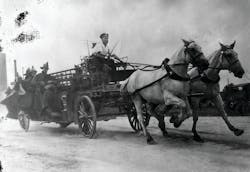ADA, OH: NOV. 4, 1913 – The main administration building of Ohio Northern University was destroyed by an early-morning fire. The hard work of local firefighters was credited with saving the adjoining Brown Auditorium and several nearby residences. Lost in the flames were a valuable pipe organ, many valuable records and the library.
PARIS, FRANCE: NOV. 5, 1913 – The Marseilles-Lyons-Paris Express train was involved in a deadly collision with another train during the night. Seven coaches filled with passengers were reduced to wooden shards that quickly caught fire. Firemen were faced with numerous injuries, 12 dead passengers and a growing fire. The crash occurred near Melun, 27 miles from Paris. Every doctor in the area was summoned and extrication and firefighting continued until midnight.
NEW YORK CITY: NOV. 8, 1913 – An explosion of gasoline that had accumulated in the sewer running under Broadway, 55th Street and Sixth Avenue shook the entire neighborhood like an earthquake at 9:30 A.M. Sixteen manhole covers were launched high into the air and damaged numerous buildings. Ten people were injured by flying glass or burned by the flames that shot 15 feet high from the sewer openings.
MONTREAL, CANADA: NOV. 9, 1913 – A fire in the Bell Telephone main exchange building knocked out telephone service for the entire city. Businesses and homes were without telephone service for at least a month. With large businesses, financial establishments and brokerage houses without telephones, messenger services were in high demand.
GREAT LAKES REGION: NOV. 9, 1913 – A huge storm, called by many as the “Great Lakes Hurricane,” raged across the region with high winds and heavy snow. The storm pounded the areas around the lakes for two straight days, first coating everything with freezing rain, then switching to a heavy wet snow that left behind 18 to 25 inches of paralyzing precipitation. Twelve commercial lake boats were lost with their entire crews, taking the lives of more than 235 sailors. Food and milk shortages developed when trains were stranded and unable to move on snow-buried tracks. In Cleveland, OH, several large buildings collapsed under the tremendous weight of the snow. Fearing potential fire problems, the Cleveland Fire Department increased the size of its fire horse teams from three to five and the Boy Scouts were mobilized to help clear buried fire hydrants.
NEW YORK CITY: NOV. 15, 1913 – Four alarms were required to extinguish a difficult fire that began in the subcellar of ship supply warehouse on South Street. As the fire spread to a nearby seven-story hotel, firemen were faced with an extremely difficult smoke condition from burning rope, oilcloths, tarpaulins and oils.
HAMILTON, BERMUDA: NOV. 16, 1913 – The Spanish steamer Balmes, which caught fire at sea, arrived in port accompanied by the Cunard Line ship Pannonia. The fire was still burning in the hold of the Balmes, as the 103 passengers rescued from the burning ship headed to New York onboard the Pannonia. Firefighters and crewmembers moved in on the burning ship with pumps and hoses and soon had the fire under control. The captain of the Pannonia said the real heroes of the disaster were Captain Juan Ruiz and his crew, who fought the fire in baled cotton stored in a hold below decks day and night until they dropped from exhaustion.
SAINT MARIE, QUEBEC: NOV. 22, 1913 – Fire swept through this town of 1,600 people, destroying 150 homes. Flames were still out of control when a call for aid went out. Every piece of firefighting equipment that could be spared from neighboring communities was requested and were sent by special trains.
PAUL HASHAGEN, a Firehouse® contributing editor, is a retired FDNY firefighter who was assigned to Rescue 1 in Manhattan. He is also an ex-chief of the Freeport, NY, Fire Department. Hashagen is the author of FDNY: The Bravest, An Illustrated History 1865-2002, the official history of the New York City Fire Department, and other fire service books. His latest novel, Fire of God, is available at dmcfirebooks.com.
About the Author
Paul Hashagen
PAUL HASHAGEN, a Firehouse® contributing editor, is a retired FDNY firefighter who was assigned to Rescue 1 in Manhattan. He is also an ex-chief of the Freeport, NY, Fire Department. Hashagen is the author of FDNY: The Bravest, An Illustrated History 1865-2002, the official history of the New York City Fire Department, and other fire service books.
Connect with Paul
Website: paulhashagen.com
Facebook: Paul Hashagen-author
